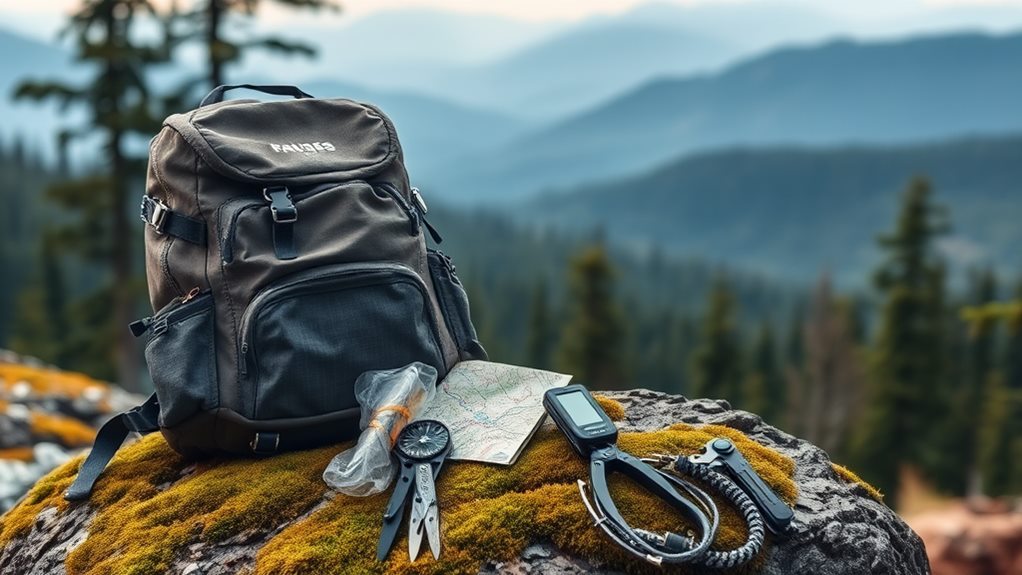For backcountry hiking, having the right navigation tools can make all the difference. First, a topographic map helps you understand elevation changes and identify landmarks. A compass keeps you oriented, while GPS devices offer precision in tracking your route. Don't forget smartphone apps that provide offline maps and enhance GPS accuracy. An altimeter tracks elevation, adding valuable insights. Carry an emergency whistle for distress signals and consider reflective gear for visibility. Trail guides and navigation software help in planning and adjusting routes. These essentials set you up for success; you'll discover even more tools and tips for your adventure soon!
Key Takeaways
- Topographic maps are vital for understanding terrain and elevation changes, aiding in effective route planning and navigation.
- A compass is essential for accurate navigation, helping hikers orient themselves and master orienteering skills.
- GPS devices provide precise location information, waypoint marking, and user-friendly interfaces for easier navigation in the backcountry.
- Smartphone apps with offline maps enhance GPS accuracy and foster community engagement through social sharing of hiking experiences.
- Personal Locator Beacons (PLBs) ensure safety by allowing hikers to send SOS signals for rescue in remote areas.
Topographic Maps
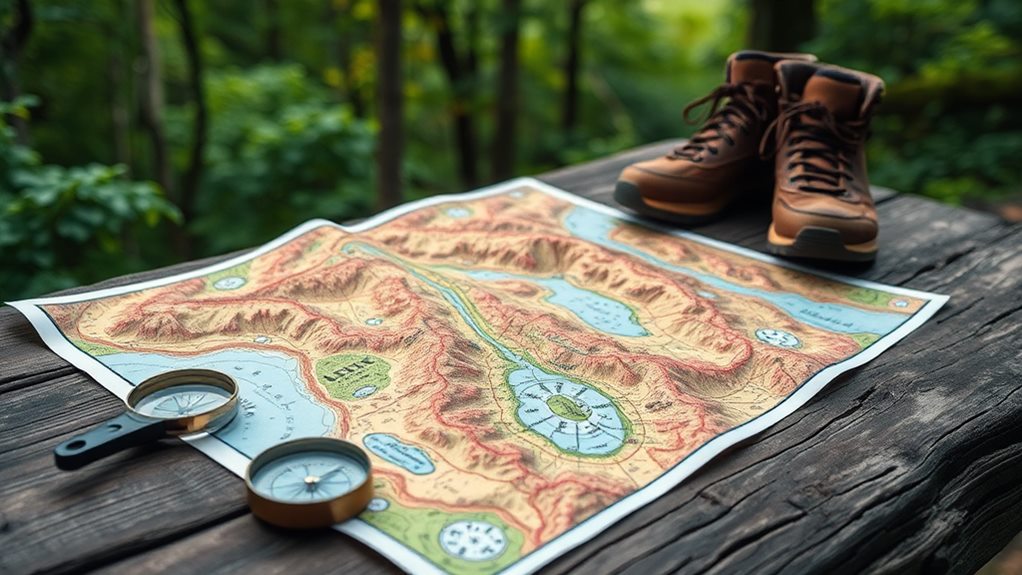
When you head into the backcountry, topographic maps become your essential companion. These maps are more than just pieces of paper; they're your guide to understanding the lay of the land. As you study them, you'll notice the intricate lines depicting elevation changes, revealing the peaks and valleys that shape your adventure. By interpreting these contour lines, you can anticipate challenging climbs or gentle slopes, making your journey not just a hike, but a well-planned expedition.
Utilizing a reliable hiking GPS device can further enhance your navigation, providing real-time data and additional layers of information that complement your map reading skills.
As you navigate, landmark identification becomes essential. You'll find that mountains, rivers, and forests are all marked clearly, providing reference points that help ground you in the wilderness. With a topographic map in hand, you'll gain the confidence to explore beyond the beaten path, using these landmarks to orient yourself and connect with the environment around you.
Understanding how elevation changes impact your hike is vital. You'll not only become aware of how steep an ascent might be, but you'll also appreciate the breathtaking views that await you at the summit. Each peak you climb brings a sense of accomplishment and belonging to the wild.
Compasses
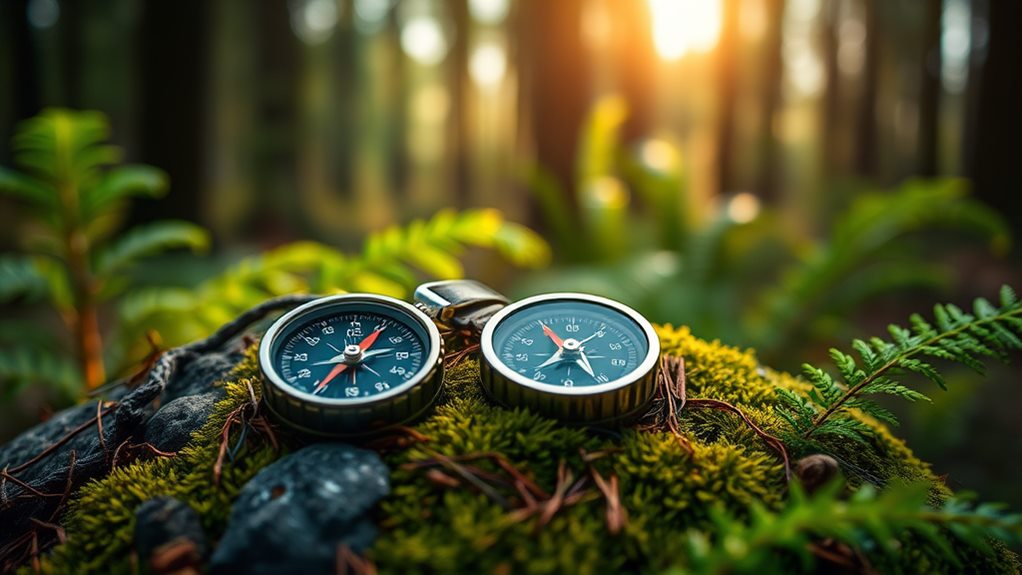
A dependable compass is an invaluable tool for backcountry hiking, providing precise directional guidance in areas where digital devices may fail. With a compass in hand, you can navigate through dense forests, rocky terrains, and vast open spaces. Understanding how to use it effectively is key, and mastering orienteering techniques can enhance your confidence on the trail.
Just as laser measuring tools enhance precision in construction projects, a compass guarantees accuracy in your navigation efforts, equipping you with the ability to confidently chart your course for improved project outcomes.
To start, familiarize yourself with your compass's components: the needle, baseplate, and directional arrow. When you need to find your way, hold the compass flat and rotate your body until the needle aligns with the north marking. This simple action connects you with your surroundings, allowing you to chart a course with accuracy.
Regular compass maintenance is crucial to guarantee its reliability. Keep it away from magnetic fields, like electronics or metal objects, which can throw off its readings. Periodically check for any dirt or moisture in the housing, and store it in a protective case when not in use. By taking care of your compass, you're not just protecting a tool; you're safeguarding your adventures.
As you develop your orienteering skills, practice taking bearings and setting a course. The more you use your compass, the more intuitive it will become. Embrace the sense of belonging that comes with mastering these skills, connecting you to fellow hikers who share your passion for exploration. With a compass by your side, you're prepared to traverse the wilderness with confidence and clarity.
GPS Devices
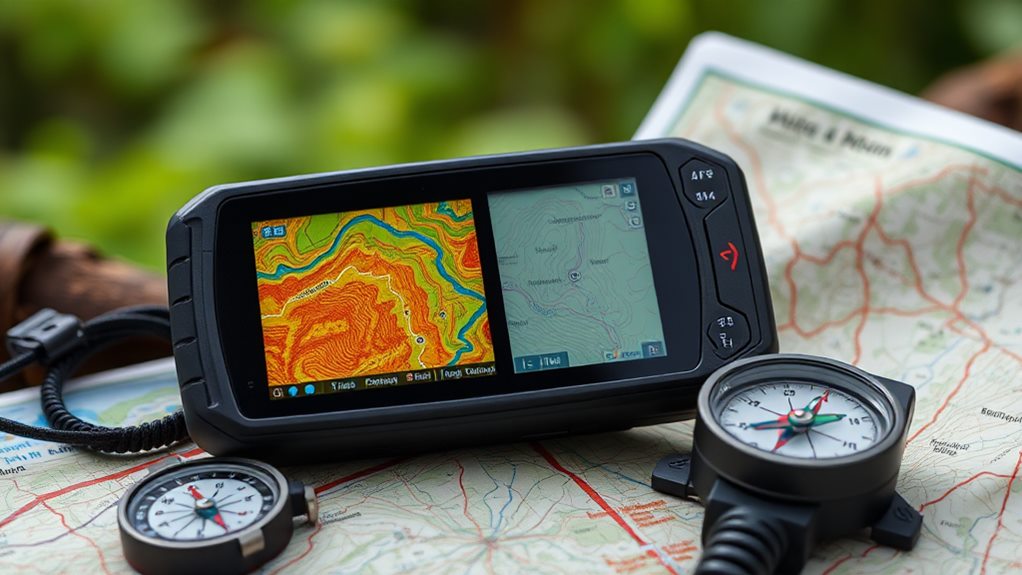
GPS devices have revolutionized backcountry hiking, offering hikers unparalleled precision and convenience in navigation. With the ability to pinpoint your location using satellite tracking, these tools remove much of the guesswork from your adventures.
Imagine standing in the heart of a dense forest, surrounded by towering trees, and knowing exactly where you're in relation to your trailhead or destination. That's the power of a GPS device. Many GPS trackers also feature real-time location monitoring, allowing hikers to stay informed about their position even in challenging terrains.
Waypoint marking is another standout feature that enhances your experience. You can save specific locations, like scenic viewpoints or tricky junctions, allowing you to easily return to those spots later. This isn't just about finding your way; it's about creating a personalized map of your journey.
You'll feel more connected to the landscape as you mark places that resonate with you, turning a simple hike into a collection of cherished memories.
Plus, the user-friendly interfaces on modern GPS devices mean you don't have to be a tech whiz to navigate effectively. Many models come with preloaded maps, giving you instant access to trails and terrain information.
Whether you're hiking solo or with friends, sharing your waypoints can foster a sense of camaraderie, as you all explore together.
In the backcountry, every decision matters. With a GPS device in hand, you'll feel confident and empowered, ready to embrace the beauty of nature without the fear of getting lost. So gear up, and let technology guide you as you forge unforgettable paths through the wilderness.
Smartphone Apps

How can you guarantee you're always on the right path during your backcountry hikes? One of the best ways is by leveraging smartphone apps designed specifically for wayfinding. These tools aren't just handy; they can be lifesavers. With the right app, you'll have access to offline maps, allowing you to download trails and topographical data before you head out. That means you won't have to rely on cell service, which can be spotty in remote areas.
When choosing an app, look for features that enhance your GPS accuracy. Many modern hiking apps utilize advanced technology to pinpoint your location with impressive precision. This can make all the difference when you're maneuvering through dense forests or rocky terrains. The last thing you want is to second-guess your position when you're out in the wild.
Moreover, these apps often come packed with additional features like trail reviews, points of interest, and even social sharing options. You can connect with fellow hikers, share your experiences, and find new trails to explore together. It creates a sense of community, making every hike feel a little less solitary.
Altimeters
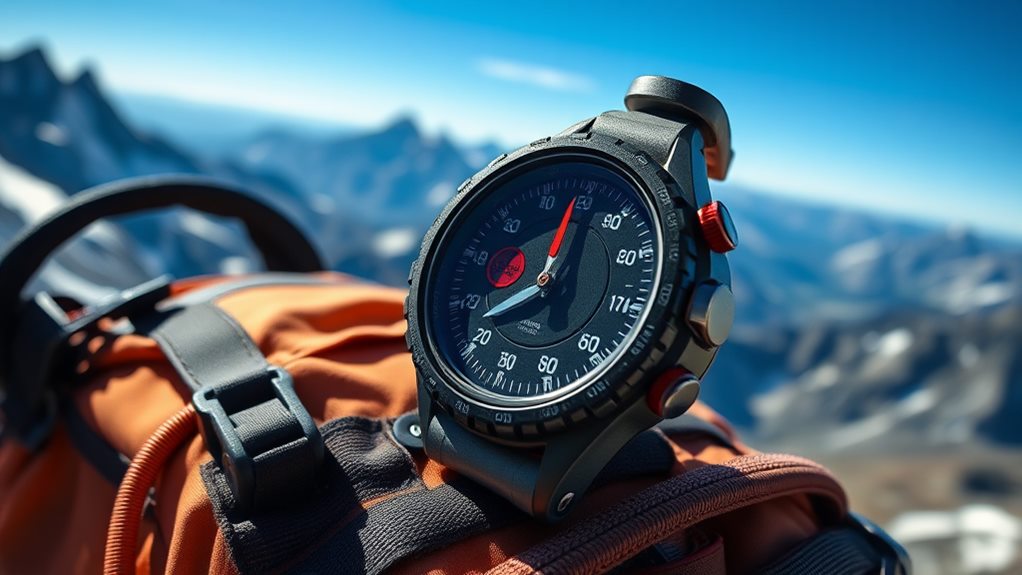
Altitude awareness is essential when exploring the backcountry, and that's where altimeters come into play. These handy devices help you track your elevation, ensuring you stay oriented and aware of your surroundings. Whether you're trekking steep trails or crossing high ridges, understanding your altitude can enhance your experience and safety.
When choosing an altimeter, you'll want to ponder its accuracy. A reliable altimeter can make a significant difference, especially in challenging terrain where landmarks might be scarce. Look for models that offer barometric pressure calibration, which adjusts for weather changes, ensuring you're always on point.
Altimeter features can also elevate your hiking experience. Many modern altimeters include GPS functionality, allowing you to combine elevation data with your current location. Some models even track your ascent and descent rates, giving you insights into your physical performance.
Additionally, you might appreciate altimeters with built-in compasses or route planning features, making it easier to stay on track and plan your next move.
Using an altimeter isn't just about finding your way; it's about connecting with the landscape around you. By incorporating this tool into your hiking gear, you'll foster a deeper understanding of the environment, helping you feel more in tune with nature.
Personal Locator Beacons

Equipping yourself with a Personal Locator Beacon (PLB) can be a lifesaver when you're venturing into the backcountry. These compact devices are designed to help you stay connected, even when you're miles away from civilization. Imagine finding yourself in a precarious situation—your ankle twists, or the weather turns severe. With a PLB in hand, you can send out SOS signals, alerting search and rescue teams to your exact location.
PLBs utilize satellite communication to transmit your distress signals. When activated, they connect with a network of satellites, guaranteeing your message reaches the nearest rescue center, regardless of where you are. This level of connectivity gives you peace of mind, allowing you to focus on your adventure without the constant worry about getting lost or injured.
What's more, many PLBs are waterproof and rugged, designed to withstand the harsh conditions often found in the backcountry. They're lightweight and easy to carry, making them an essential addition to your hiking gear.
When you hit the trails, you not only equip yourself with navigation tools but also secure that you have a reliable lifeline should the unexpected occur.
Trail Guides
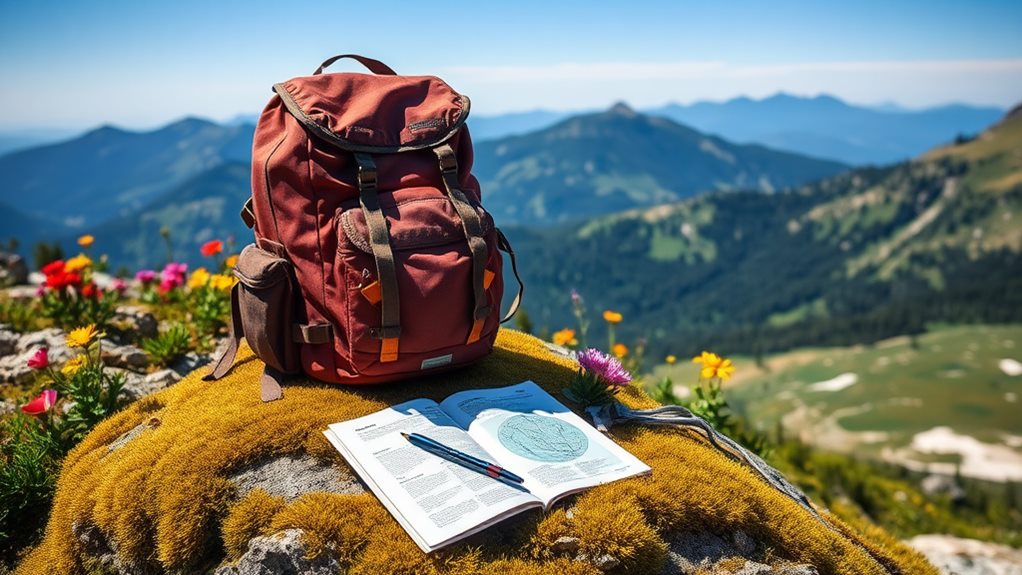
Exploring the backcountry becomes a more enriching experience when you have a reliable trail guide in hand. A good trail guide not only leads you through stunning landscapes but also educates you on essential aspects of your adventure. It covers trail etiquette, ensuring you know how to respect nature and fellow hikers. You'll learn to yield to others on narrow paths and practice Leave No Trace principles.
Here's a quick overview of what to expect from a trail guide:
| Aspect | Description | Significance |
|---|---|---|
| Safety Tips | First aid info, weather updates | Keeps you prepared and safe |
| Scenic Views | Highlighted viewpoints along the route | Enhances your hiking experience |
| Wildlife Encounters | Information on local fauna | Promotes awareness and respect |
Having a trail guide also means you're equipped with necessary safety tips. You'll find instructions on what to do during unexpected wildlife encounters, helping you stay calm and collected. Plus, many guides feature maps that showcase scenic views, so you won't miss breathtaking spots perfect for photos or quiet reflection.
As you trek through the wilderness, a trusted trail guide fosters a sense of belonging within the hiking community. It connects you to the land and its stories while preparing you for the journey ahead. So, before you hit the trails, make sure to pack that guide and immerse yourself in the beauty and adventure that awaits you!
Navigation Software
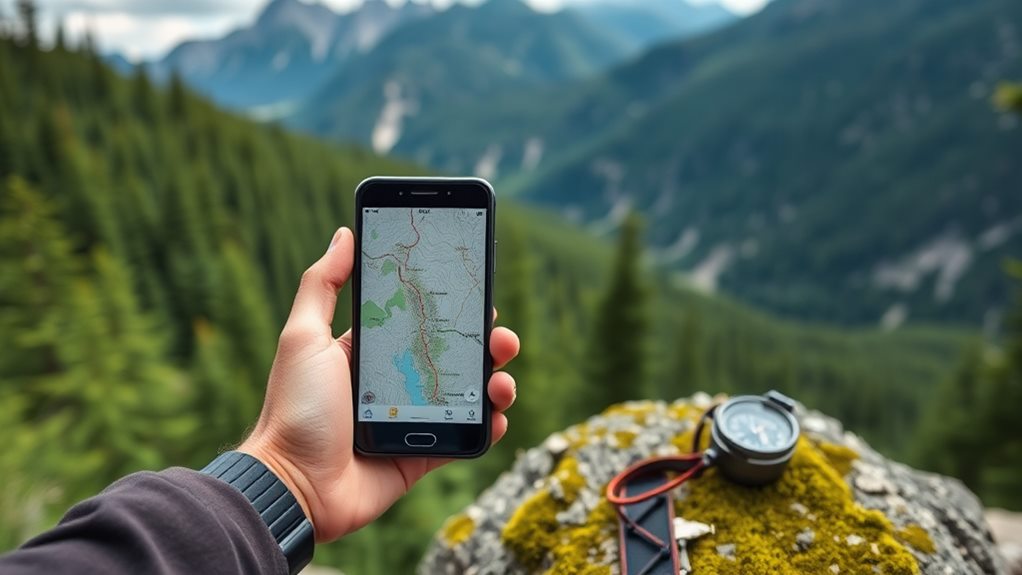
While a reliable trail guide provides invaluable insights, navigation software takes your backcountry hiking experience to the next level. Imagine having a powerful tool in your pocket that not only helps you explore new trails but also keeps you safe and on course. With apps designed specifically for outdoor enthusiasts, you can access offline maps, ensuring you're never lost, even when cell service fades away.
Route planning becomes a breeze with navigation software. You can easily plot your journey, mark waypoints, and adjust your path based on real-time information. This flexibility allows you to adapt to changing conditions, whether it's a sudden rainstorm or an unexpected detour.
Plus, many apps feature user-generated content, which means you can tap into the wisdom of fellow hikers—sharing tips, photos, and experiences that enhance your adventure.
As you navigate through breathtaking landscapes, these tools foster a sense of community. You're not just hiking; you're part of a network of explorers, all sharing the same passion for discovery. With navigation software, you can connect with others, find popular trails, and even join group hikes, ensuring you never feel alone on your journey.
Emergency Whistles
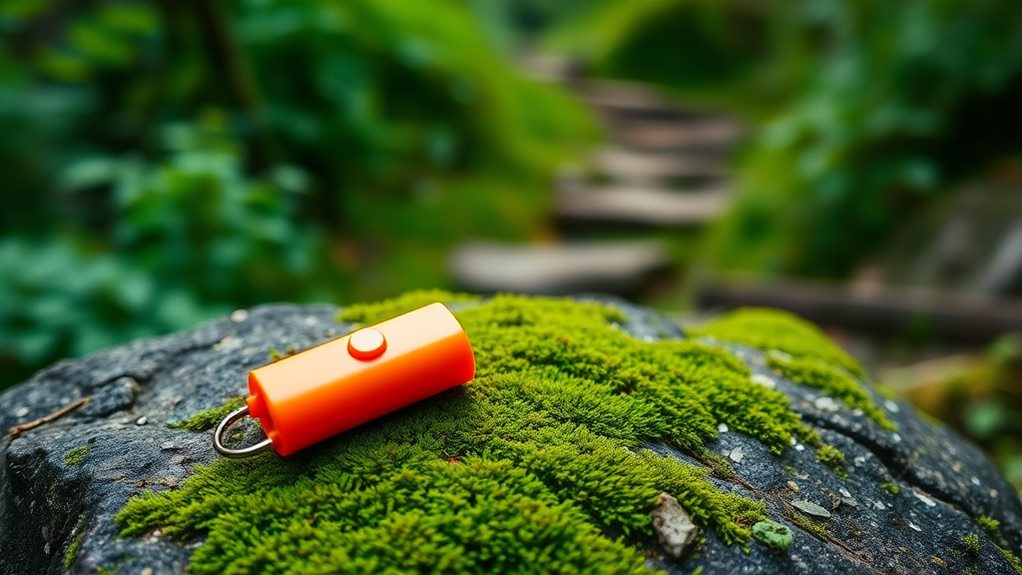
When venturing into the backcountry, having an emergency whistle can be a game-changer in critical situations. This small yet powerful tool serves as your voice when you need it most, helping you signal safety to rescuers or fellow hikers. In the vast wilderness, your voice might get lost, but an acoustic alert from a whistle can carry much farther, cutting through the sounds of nature.
Emergency whistles are designed to be lightweight and easy to carry, making them an essential addition to your gear. Unlike shouting, which can quickly wear you out, a single blow on your whistle can produce sound that travels over long distances.
In an emergency, three short blasts are the universal distress signal, letting others know you need help.
Imagine you're lost or injured, and your phone's battery is dead. Panic can set in, but the reassuring sound of your whistle provides a lifeline. It's not just about you; it's about fostering a sense of community and belonging among fellow hikers.
Reflective Gear

Shining brightly in low-light conditions, reflective gear is an essential component of your backcountry hiking kit. When you're exploring trails that lead you into the twilight hours or moving through dense forests, ensuring your nighttime visibility is vital for your safety and the safety of your companions. Reflective clothing and accessories can make all the difference when it comes to being seen by others, whether it's fellow hikers or emergency responders.
Imagine hiking along a serene trail as the sun dips below the horizon. The last rays of light fade, but with reflective gear, you'll stand out against the backdrop of darkness. Reflective jackets, vests, or even backpacks can catch light from passing vehicles or flashlights, alerting others to your presence.
Accessories like reflective bands or headlamps can further enhance your visibility, making you feel more secure as you venture into the unknown.
Incorporating reflective elements into your hiking wardrobe not only boosts safety but also fosters a sense of community. When you and your friends wear bright, reflective gear, you signal that you care about each other's safety, creating a bond that goes beyond the trail.
Frequently Asked Questions
What Should I Do if I Get Lost in the Backcountry?
If you get lost in the backcountry, stay calm and assess your surroundings. Use survival techniques like finding water and shelter to maintain your strength. Create emergency signals, such as three loud whistles or three ground markings, to attract attention.
If you've got a map and compass, try to retrace your steps. Remember, staying put can often be your best option until help arrives. Trust your instincts and keep your spirits up.
Can I Rely Solely on My Smartphone for Navigation?
Absolutely, relying solely on your smartphone for navigation might seem like trusting a squirrel to guide you through a maze!
While offline maps can be lifesavers, your phone's battery life can disappear faster than a magician's rabbit.
If you're deep in the wilderness, that one device can turn into a paperweight.
Always have a backup plan, like a traditional map and compass, to guarantee you're not left wandering like a lost puppy!
How Do I Choose the Right Map for My Hike?
Choosing the right map for your hike can make all the difference. If you're exploring rugged terrain, a topographic map provides elevation details, while trail maps highlight established paths. Consider whether you prefer the tactile feel of paper maps or the convenience of digital ones, which often come with GPS features.
Whichever you choose, make sure it suits your adventure, enhances your experience, and keeps you connected to the beautiful wilderness around you.
What Skills Are Essential for Using a Compass Effectively?
Did you know that over 70% of hikers rely on digital navigation tools but can't read a compass?
To use a compass effectively, you need to grasp compass basics, like understanding magnetic north and declination.
Master navigation techniques, including orienting the map with your compass and taking bearings.
Practice regularly and develop your skills; it'll boost your confidence in the wild.
You'll feel like part of a community that values outdoor adventure and exploration!
Are There Any Specific Regulations for Using GPS Devices in National Parks?
When you're exploring National Parks, you need to be aware of GPS device regulations. Many parks allow GPS use, but some have restrictions to protect wildlife and natural resources. If you're into geocaching, check the specific rules for that park, especially in wilderness areas, where regulations can be stricter.
Staying informed helps you enjoy your adventure while respecting the beauty around you. Always prioritize safety and preservation during your outdoor experiences!
Conclusion
As you venture into the backcountry, remember that nearly 70% of hikers get lost at some point. Equip yourself with the essential navigation tools we've covered, from topographic maps to smartphone apps, and you'll boost your confidence and safety. Embrace the adventure, knowing you're prepared for whatever nature throws your way. With the right gear at your side, you can explore with ease and immerse yourself in the breathtaking beauty around you. Happy hiking!

